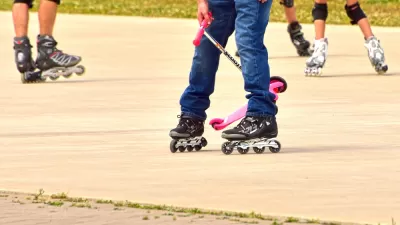Urban areas are filled with cars, and this creates an unsafe environment for children. This commentary argues that officials need to regain their faith in the power of planning to address the issue.
"Researchers at the University of the West of England have found that people who live in busy roads have fewer friends and acquaintances nearby, and feel worse about their neighbourhoods, than those in socio-economically similar but less traffic-filled streets. As John Vidal reported in last Friday's Guardian, the consequences could be far-reaching, given the links between neighbourliness and positive outcomes in many areas of people's lives."
"Traffic-filled streets are a double whammy for children. Road danger is a direct and lethal threat, and a realistic fear for parents, especially in the UK, which has a poor record on child pedestrian casualties compared to most other European countries. But car dependence also impoverishes children's lives, severing their links with the people and places around them."
"The point about traffic is that it is one area of public policy where the politicians have direct access to the key levers of change, through the planning system. Yet we have lost faith in the very idea that planning is a good way to tackle complex social problems. As a result, government policies are vague and wishy-washy at best, and local authorities don't have the political will to challenge the status quo. As a result, children are left exposed to the brutal market forces of individual adult choices."
FULL STORY: A world in a windscreen

Trump Administration Could Effectively End Housing Voucher Program
Federal officials are eyeing major cuts to the Section 8 program that helps millions of low-income households pay rent.

Planetizen Federal Action Tracker
A weekly monitor of how Trump’s orders and actions are impacting planners and planning in America.

Ken Jennings Launches Transit Web Series
The Jeopardy champ wants you to ride public transit.

Washington Legislature Passes Rent Increase Cap
A bill that caps rent increases at 7 percent plus inflation is headed to the governor’s desk.

From Planning to Action: How LA County Is Rethinking Climate Resilience
Chief Sustainability Officer Rita Kampalath outlines the County’s shift from planning to implementation in its climate resilience efforts, emphasizing cross-departmental coordination, updated recovery strategies, and the need for flexible funding.

New Mexico Aging Department Commits to Helping Seniors Age ‘In Place’ and ‘Autonomously’ in New Draft Plan
As New Mexico’s population of seniors continues to grow, the state’s aging department is proposing expanded initiatives to help seniors maintain their autonomy while also supporting family caregivers.
Urban Design for Planners 1: Software Tools
This six-course series explores essential urban design concepts using open source software and equips planners with the tools they need to participate fully in the urban design process.
Planning for Universal Design
Learn the tools for implementing Universal Design in planning regulations.
Heyer Gruel & Associates PA
Ada County Highway District
Institute for Housing and Urban Development Studies (IHS)
City of Grandview
Harvard GSD Executive Education
Toledo-Lucas County Plan Commissions
Salt Lake City
NYU Wagner Graduate School of Public Service




























